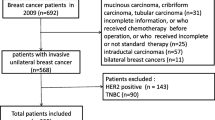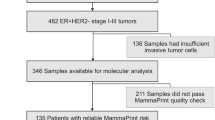Abstract
Background
The St. Gallen consensus provides treatment recommendations for breast cancer based on prognostic factors. Although many patients’ prognostic patterns are not easily matched with the prognostic patterns listed in the St. Gallen consensus, there has been no systematic investigation reporting the gap between treatment recommendations and actual postoperative treatment choices in clinical practice.
Methods
Four hundred seventy-one patients with hormone receptor-positive [HR(+)] and human epidermal growth factor receptor type 2-negative [HER2(−)] breast cancer were analyzed. These patients were classified into either the “crisp treatment group” or “fuzzy treatment group” based on the definitiveness of postoperative treatment selection based on St. Gallen treatment recommendations. The patients in the fuzzy treatment group were further classified into strata in which patients within each stratum shared the same prognostic factor patterns with similar recurrence rates.
Results
A total of 87.3 % of HR(+)HER2(−) patients were designated to the fuzzy treatment group. Four prognostic strata were constructed according to the survival tree model, and revealed that patients with poor prognostic profiles tended to receive endocrine therapy with chemotherapy. This suggests that postoperative chemotherapy is useful, although there was no statistical significance.
Conclusions
We constructed prognostic profiles of patients in the fuzzy treatment group and examined the recurrence rates associated with two treatment regimens within each prognostic profile. These findings are exploratory, but they may be useful for planning prospective studies of the effectiveness of postoperative treatment regimens among patients with a heterogeneous combination of prognostic factors.




Similar content being viewed by others
References
Fisher B, Redmond C, Dimitrov NV et al (1989) A randomized clinical trial evaluating sequential methotrexate and fluorouracil in the treatment of patients with node-negative breast cancer who have estrogen-receptor-negative tumors. N Engl J Med 320:473–478
Fisfer B, Costantino J, Redmond C et al (1989) A randomized clinical trial evaluating tamoxifen in the treatment of patients with node-negative breast cancer who have estrogen-receptor-positive tumors. N Engl J Med 320:479–484
LHRH-agonists in Early Breast Cancer Overview Group, Cuzick J, Ambroisine L, Davidson N et al (2007) Use of luteinising-hormone-releasing hormone agonists as adjuvant treatment in premenopausal patients with hormone-receptor-positive breast cancer: a meta-analysis of individual patient data from randomized adjuvant trials. Lancet 369(9574):1711–1723
Piccart MJ, Di Leo A, Beauduin M et al (2001) Phase III trial comparing two dose levels of epirubicin combined with cyclophosphamide with cyclophosphamide, methotrexate, and fluorouracil in node-positive breast cancer. J Clin Oncol 19:3103–3110
Sonoo H, Kurebayashi J (2001) Endocrine therapy for advanced or recurrent breast cancer. Jpn J Cancer Chemother 28:909–916
Slamon DJ, Clark GM, Wong SG et al (1987) Human breast cancer: correlation of relapse and survival with amplification of the HER2/new oncogene. Science 235:177–182
Goldhirsch A, Ingle JN, Gelber RD et al. (panel members) (2009) Thresholds for therapies: highlights of the St. Gallen International Expert Consensus on the primary therapy of early breast cancer 2009, Ann Oncol 20:1319–1329
Wolf AC, Hammond ME, Schwartz JN et al (2007) American Society of Clinical Oncology/College of American Pathologists guideline recommendations for human epidermal growth factor receptor 2 testing in breast cancer. J Clin Oncol 25:118–145
Berry DA, Cirrincione C, Henderson IC et al (2006) Estrogen-receptor status and outcomes of modern chemotherapy for patients with node-positive breast cancer. JAMA 95:1658–1667
Garibaldi JM, Zhou SM, Wang XY et al (2012) Incorporation of expert variability into breast cancer treatment recommendation in designing clinical protocol guided fuzzy rule system models. J Biomed Inform 45:447–459
Klir GJ, Folger TA (1988) Fuzzy Sets, Uncertainty, and Information. Prentice-Hall, New Jersey
Zhang H, Singer B (1999) Recursive Partitioning in the Health Sciences. Springer, New York, pp 93–103
Carletta J (1996) Assessing agreement on classification tasks: the kappa statistic. Comput Linguist 22:249–254
Banerjee M, Biswas D, Sakr W et al (2000) Recursive partitioning for prognostic grouping of patients with clinically localized prostate carcinoma. Cancer 89:404–411
Kwak LW, Halpern J, Olshen RA et al (1990) Prognostic significance of actual dose intensity in diffuse large-cell lymphoma: results of a tree-structured survival analysis. J Clin Oncol 8:963–977
Guo J, Wang W, Liao P et al (2009) Identification of serum biomarkers for pancreatic adenocarcinoma by proteomic analysis. Cancer Sci 100:2292–2301
Warwick J, Vardaki E, Fattizzi N et al (2009) Defining the surgical management of suspected early-stage ovarian cancer by estimating patient numbers through alternative management strategies. BJOG 116:1225–1241
Bacchetti P, Segal MR (1995) Survival trees with time-dependent covariates: application to estimating changes in the incubation period of AIDS. Lifetime Data Anal 1:35–47
Carmelli D, Halpern J, Swan GE et al (1991) 27-year mortality in the Western Collaborative Group study: construction of risk groups by recursive partitioning. J Clin Epidemiol 44:1341–1351
Carmelli D, Zhang HP, Swan GE (1997) Obesity and 33 years of coronary heart disease and cancer mortality in the Western Collaborative Group study. Epidemiology 8:378–383
Brewster AM, Hortobagyl GN, Broglio KR et al (2008) Residual risk of breast cancer recurrence 5 years after adjuvant therapy. J Natl Cancer Inst 100:1179–1183
Saphner T, Tormey DC, Gray R (1996) Annual hazard rates of recurrence for breast cancer after primary therapy. J Clin Oncol 14:2738–2746
Makita M, Iwase T, Tada T et al (2004) The site and timing of the first recurrence of breast cancer. Jpn J Breast Cancer 19:343–351
Morgan JA, Sonquist JA (1963) Problems in the analysis of survey data, and a proposal. J Am Stat Assoc 58:415–434
Breiman L, Friedman JH, Oishen R et al (1984) Classification and Regression Trees. Wadsworth International Group, Belmony
Davis R, Anderson J (1989) Exponential survival trees. Stat Med 8:947–962
de Azambuja E, Cardoso F, de Castro G Jr et al (2007) Ki67 as prognostic marker in early breast cancer: a meta-analysis of published studies involving 12,155 patients. Br J Cancer 96:1504–1513
Paik S, Shak S, Tang G et al (2004) A multigate assay to predict recurrence of tamoxifen- treated, node-negative breast cancer. N Engl J Med 351:2817–2826
Van’t Veer LJ, Dai H, van de Vijver MJ et al (2002) Gene expression profiling predicts clinical outcome of breast cancer. Nature 415:530–536
Author information
Authors and Affiliations
Corresponding author
Rights and permissions
About this article
Cite this article
Satoh, K., Tanaka, M., Yano, A. et al. Treatment When Prognostic Factors Do Not Match St. Gallen Recommendations: Profiling of Prognostic Factors among HR(+) and HER2(−) Breast Cancer Patients. World J Surg 37, 516–524 (2013). https://doi.org/10.1007/s00268-012-1881-9
Published:
Issue Date:
DOI: https://doi.org/10.1007/s00268-012-1881-9




